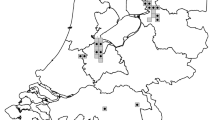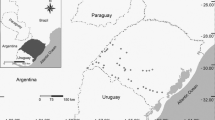Abstract
The Strawberry Darter Etheostoma fragi is endemic to the Strawberry River drainage in northcentral Arkansas, where its distribution and status have not been assessed since the mid-1990s. A status survey was conducted during the summers of 2015 and 2016. Sixty-four sites were sampled (32 each summer) within the Strawberry River drainage. Sites were surveyed 4 times each using a kick-seine. A total of 236 E. fragi were observed during the study. E. fragi were observed at 24 of 64 sites, including 15 tributary and 9 main stem sites. Strawberry Darters were observed at sites with a median (range) dissolved oxygen of 9.2 (5.7–11.9) mg/L, median stream flow of 0.2 (0.1–0.7) m/s, median pH of 8.1 (6.7–9.4), median water temperature of 22.0 (13.9–29.3) °C, and median depth of 0.2 (0.1–0.7) m. Presence/absence data were analyzed with occupancy modeling, which estimates informed occupancy rate (hereafter, occupancy) and probability of detection. The drainage-wide occupancy (± SE) was 0.41 ± 0.06 and the probability of detection was 0.56 ± 0.06. A reach covariate model fit our data the best (209.81 AICc). This model estimated an occupancy of 0.54 ± 0.09 and a probability of detection of 0.64 ± 0.06 in the upper reach, an occupancy of 0.20 ± 0.11 and a probability of detection of 0.51 ± 0.17 in the middle reach, and an occupancy of 0.39 ± 0.31 and a probability of detection of 0.19 ± 0.16 in the lower reach The drainage-wide occupancy was lower (0.32 difference) than an occupancy based on historical data (0.73 ± 0.11). These results suggest a decline in the status of E. fragi and justify conservation measures to preserve this species.





Similar content being viewed by others
Data availability
Distribution data will be input to Global Biodiversity Information Facility (GBIF). Covariate data and sampling will be placed into an on-line data repository, i.e. Dryad.
References
ADEQ (Arkansas Department of Environmental Quality) (2003) Physical, chemical and biological assessment of the Strawberry River watershed. Report No. WQ-03-12-01. Arkansas Department of Environmental Quality – Water Division, Little Rock, Arkansas
AGFC (Arkansas Game and Fish Commission) (2006) Arkansas wildlife action plan. Arkansas Game and Fish Commission, Little Rock, Arkansas, pp 443–445
AGFC (Arkansas Game and Fish Commission) (2016) Arkansas wildlife action plan. Arkansas Game and Fish Commission, Little Rock, Arkansas, pp 407–409
Akaike H (1973) Information theory and an extension of the maximum likelihood principle. In: Petrov BN, Csáaki F (eds.) Second International Symposium Information Theory. Akademiai Kiado, Budapest, pp 267–281
Albanese B, Litts T, Camp M, Weiler DA (2014) Using occupancy and species distribution models to assess the conservation status and habitat use of the goldline darter (Percina aurolineata) in Georgia, USA. Ecol Freshw Fish 23:347–359
Anderson GB, Freeman MC, Hagler MM, Freeman BJ (2012) Occupancy modeling and estimation of the Holiday Darter species complex within the Etowah River system. Trans Am Fish Soc 141:34–45
Brueggen-Bowman TR, Bouldin JL (2012) Characterization of temporal and spatial variation in subwatersheds of the Strawberry River, AR, prior to implementation of agricultural best management practices. Ark Acad Sci 66:41–49
Burnham KP, Anderson DR (2004) Multimodal inference: understanding AIC and BIC in model selection. Sociol Methods Res 33:261–304
CAST (Center for Advanced Spatial Technologies) (2006) Strawberry River land use-land cover data. Biological and Agricultural Engineering Department, University of Arkansas, Fayetteville, Arkansas http://www.arkansaswater.org/NPSmanagementPlan/Images/Chapter18/Figure12LandUes_Map.jpg. Accessed 5 Dec 2016
Ceas PA, Page LM (1997) Systematic studies of the Etheostoma spectabile complex (Percidae; Subgenus Oligocephalus), with descriptions of four new species. Copeia 3:496–522
Dauwalter DC, Pert EJ, Keith WK (2003) An index of biotic integrity for fish assemblages in Ozark Highland streams of Arkansas. Southeast Nat 2:447–468
Dauwalter D, Rahel F, Fisher B (2010) Warmwater streams. In: Hubert WA, Quist MC (eds) Inland Fisheries Management in North America, 3rd edn. American Fisheries Society, Bethesda
Dextrase AJ, Mandrak NE, Schaefer JA (2014) Modeling occupancy of an imperiled stream fish at multiple scales while accounting for imperfect detection: implications for conservation. Freshw Biol 59:1799–1815
Diana JS (2004) Biology and ecology of fishes. Cooper Publishing Group, Traverse City
Distler DA (1968) Distributions and variation of Etheostoma spectabile (Agassiz) (Percidae, Teleostei). Univ Kans Sci Bull 48:143–208
FTN (FTN Associates Ltd.) (2016) Strawberry River watershed-based management plan. FTN No. R03015-0005-014. FTN Associates Ltd., Rock L, Arkansas http://arkoalition.org/wp-content/uploads/2016/11/Strawberry-River-WMP-2016-04-011.pdf. Accessed 24 Apr 2016
Groce MC, Bailey LL, Fausch KD (2012) Evaluating the success of Arkansas Darter translocations in Colorado: an occupancy sampling approach. Trans Am Fish Soc 141:825–840
Hilburn DC (1984) A comparative study of the fishes of the Strawberry River. Master’s thesis. Arkansas State University, Jonesboro
Hines JE (2006) PRESENCE12 – Software to estimate patch occupancy and related parameters. U.S. Geological Survey – Patuxent Wildlife Research Center https://www.mbrpwrc.usgs.gov/software/presence.html Accessed 14 July 2014
Hurvich C, Shumway R, Tsai C (1990) Improved Estimators of Kullback-Leibler Information for Autoregressive Model Selection in Small Samples. Biometrika 77:709–719
Layher WG (2003) Changes in fish community structure in the Bayou Bartholomew of southeast Arkansas as a result of watershed improvements made through 319 grant initiatives. Arkansas Soil and Water Conservation Commission, Little Rock, Arkansas, Report No. 99–400
MacKenzie DI et al (2002) Estimating site occupancy rates when detection probabilities are less than one. Ecology 83:2248–2255
MacKenzie DI et al (2003) Estimating site occupancy, colonization, and local extinction when a species is detected imperfectly. Ecology 84:2200–2207
MacKenzie DI et al (2006) Occupancy estimation and modeling: inferring patterns and dynamics of species occurrence. Elsevier Academic Press, Burlington
MacKenzie DI et al (2017) Occupancy estimation and modeling: inferring patterns and dynamics of species occurrence , 2nd edn. Elsevier Academic Press, Burlington
MacKenzie DI, Royle JA (2005) Designing occupancy studies: general advice and allocating survey effort. J Appl Ecol 42:1105–1114
Magoulick DD, Lynch DT (2015) Occupancy and abundance modeling of the endangered Yellowcheek Darter in Arkansas. Copeia 103:433–439 ()
Page LM, Burr BM (2011) Peterson field guide to freshwater fishes. Haughton Mifflin Harcourt, Boston
Robison HW (1998) Status survey of the Strawberry Darter Etheostoma fragi (Distler). In: Arkansas. U.S. Fish and Wildlife Service, final project report. U.S. Fish and Wildlife Service, Office of Endangered Species, Jackson, Mississippi
Robison HW, Beadles JK (1974) Fishes of the Strawberry River in northcentral Arkansas. Ark Acad Sci 28:65–70
Robison HW, Buchannan TM (1988) Fishes of Arkansas. The University of Arkansas Press, Fayetteville
Robison HW, Harp GL (1971) A pre-impoundment limnological study of the Strawberry River in northeastern Arkansas. Ark Acad Sci 25:70–79
Robison HW, McAllister C, Carlton C, Tucker T (2008) The Arkansas endemic biota: an update with additions and deletions. J Ark Acad Sci 62:84–96
Saraswat D, Pai N, Daniels M, Riley T (2013) Development of comprehensive watershed modeling for 12-digit HUCs in selected priority watersheds in Arkansas - Phase III Strawberry River Watershed (SRW), 319 project final report. Arkansas Natural Resources Commission, Little Rock, Arkansas
Shrestha S (2015) Influences of watershed land uses on biotic and abiotic conditions in southeastern Arkansas streams of the lower Mississippi River basin. Master’s thesis. University of Arkansas at Pine Bluff, Pine Bluff
Skoog ML (2016) Characteristics of water quality and biological communities in third-order and fourth-order streams draining agricultural watersheds in the Mississippi Alluvial Plain. Master’s thesis. University of Arkansas at Pine Bluff, Pine Bluff
USEPA (U.S. Environmental Protection Agency) (1999) Rapid bioassessment protocols for use in wadeable streams and rivers: periphyton, benthic macroinvertebrates, and fish. U.S. Environmental Protection Agency, 841-B-99-002. U.S. Environmental Protection Agency, Washington D.C.
Zar JH (1999) Biostatistical analysis. Prentice Hall, Upper Saddle River
Acknowledgements
This project and the preparation of this publication was funded in part by the State Wildlife Grants Program Grant # #F14AF00807 (T-48) of the U.S. Fish and Wildlife Service through an agreement with the Arkansas Game and Fish Commission. All sampling for this project was in cooperation and approval with the University of Arkansas at Pine Bluff Institutional Animal Care and Use Committee. We would also like to thank Derek Owens, and Tyler Gray, the technicians who helped collect data for this project, members of the UAPB Fisheries Labs, as well as the numerous volunteers who helped with data collection for this project.
Funding
This project and the preparation of this publication was funded in part by the State Wildlife Grants Program Grant #F14AF00807 (T-48) of the U.S. Fish and Wildlife Service through an agreement with the Arkansas Game and Fish Commission.
Author information
Authors and Affiliations
Corresponding author
Ethics declarations
Conflicts of interest/Competing interests
None.
Declarations
None.
Code availability
No code was used in the analyses of these data, the software PRESENCE (https://www.mbr-pwrc.usgs.gov/software/presence.html) was used for models.
Additional information
Publisher’s Note
Springer Nature remains neutral with regard to jurisdictional claims in published maps and institutional affiliations.
Rights and permissions
About this article
Cite this article
Hecke, K.B., Lochmann, S.E. Occupancy and status of the strawberry darter in the Strawberry River drainage of Arkansas, USA. Environ Biol Fish 103, 1481–1493 (2020). https://doi.org/10.1007/s10641-020-01037-9
Received:
Accepted:
Published:
Issue Date:
DOI: https://doi.org/10.1007/s10641-020-01037-9




